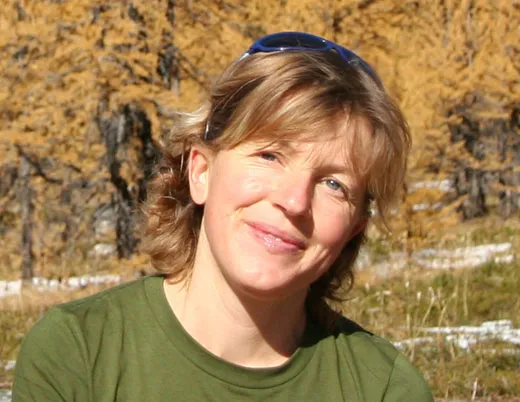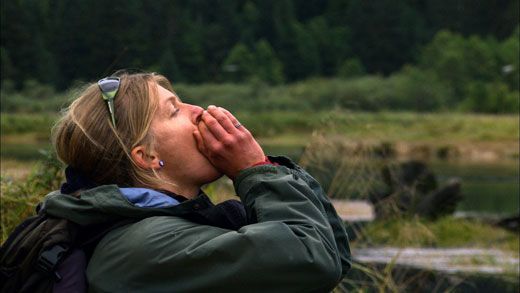Wolf Tracker
Biologist Gudrun Pflueger talks about her encounter with a Canadian pack
/https://tf-cmsv2-smithsonianmag-media.s3.amazonaws.com/filer/wolf-lady-631.jpg)
In the summer of 2005, Austrian-born field biologist Gudrun Pflueger set out on a quest to find the elusive Canadian coast wolves. With only an estimated 2,000 to 3,000 wolves inhabiting the dense forest along some 15,500 miles of shoreline, she scoured the coast of British Columbia by boat and foot in hopes that the rivers, bubbling with salmon during the spawning season, would draw the wolves into her view. Just before the end of her six-week expedition, she experienced her longed-for encounter. A small pack of wolves spotted her in a field, crept up close to her as she lay passively in the grass and ultimately accepted her presence, staying close for about an hour. Pflueger— the focus of a Smithsonian Channel documentary titled "A Woman Among the Wolves"—talks about her forays into the wild and her unique connection with wolves.
What first drew you to studying the Canadian coast wolves?
My interest in wolves started mainly because I heard about a wolf research and education organization [Central Rockies Wolf Project] based out of Canmore in the central Canadian Rockies. I wanted to support them so I sponsored or bought a partnership for one of their radio-collared wolves. If you do that you get an update about what your wolf is up to, where she's traveling and what she's experiencing. Suddenly I got this update that even if she was in a national park, wolves face high human-caused mortalities. Wildlife is under pressure because more and more people move to wild places. I actually introduced myself to this organization, and they hired me as a volunteer for snow tracking the Kootenay National Park wolf pack. I loved it so much that I decided that I'd like to make that my career. Since I was just about finished with my master's degree in biology in Austria, I thought once I'm done, I'll return to Canada and try to find another similar wolf research project. It happened that I met Chris Darimont, who leads the Coastal Wolf Research Project. He said he was just establishing a new wolf project, and the rest is history.
What makes them such an elusive pack?
First of all, the access. As a human, getting into their landscape and environment is already hard. But that's our problem. The forest is very thick, and they spend most of their time in the forest. They come out, however, along the beaches when there's low tide and along the rivers, mainly when the salmon run. They very rarely have human contact. Just in the last years, some sport hunters and outfitters moved into this area because wildlife turned out to be pretty easy to hunt or to shoot. Outfitters just went along the shorelines with their boats and shot from the boats and that made them [the wolves] very, very vulnerable and also very spooked by boats. They learn very quickly. They're social animals. They live in a pack, and if someone has a bad experience, it gets passed on to other individuals and other generations pretty quickly. That was really a high threat they started to encounter because they were pretty naïve to human hunting. The Raincoast Conservation Society bought the hunting outfitter license off the local outfitters. So the conservation society—and this is unheard of worldwide—is now also a big outfitter in Canada. Of course, they won't shoot wolves and bears.
Can you describe what it took for you to get to the area of B.C. for the film?
It's one of the wildest areas in the whole of Canada, and surely along the whole coast of North America. There are no roads and very few small native communities that are all just accessible by boat or by small float planes. Since I was working in this area already for three summer seasons, we started to think: what's the best way to travel around to find wolves? We have to be mobile. The captain of the sailboat we hired was a long-term friend and supporter of our wolf research so for me it was a no-brainer to ask him. We went with maps, and just by looking at certain topographies you can kind of predict, okay, this could be a potential wolf site, this could be a potential estuary where salmon spawn. We contacted lots of local people—local river walkers and the local communities—because the people who live there are the most connected to the land.
What was your average day like on the trip?
They were long days. Especially when we found some wolves, we got up around 4:30 a.m., had a quick breakfast on the boat and then went on land and set up a blind. Then there was lots of waiting. Then during the days we did lots of traveling, just hopped off in high amounts of bays and rivers to check for any kinds of wolf signs.
Why is it important to make human contact with the wolves?
I highly believe that due to all our technology—remote cameras, satellite, collaring, DNA samples—we get a very good theoretical idea about wildlife but the good old classic observation of what we actually study is getting less and less. It's a worldwide trend. Observation is very time consuming, and time is money. Nowadays, we want to have data right away and in high concentration. But I really think that good observation of our animals is still a very important and necessary part of understanding them so we know what they need, why they need it and to make good decisions on how to protect them and their habitats. It's especially interesting in a very social animal like the wolf. There are some sociologists who state that the social behavior of wolves is even closer to that of the human than that of the primate.
Was this your longest foray into the wild looking for the coast wolves?
I always came back to some kind of hut or park warden cabin. The longest I've camped out was five months, but every second week, I'd come out to get groceries or gas and stuff. To really get in tune with nature, it takes me a few days. The longer you are uninterrupted, just in the rhythm of nature, the easier it is to become in tune and pick up and see more and smell more and just open all your senses. When you are returning in the evening to a civilized place, it kind of slows this process down a bit.
And all you bring for protection is insect repellant and pepper spray?
I believe that if you carry around a shotgun or a gun, you approach it with the wrong mindset. We have a saying in German, which translated word for word is something like "The tone you shout into the forest, it echoes back." So if you carry around a rifle, it means ‘I am ready for fighting you.' I am sure that animals pick that up and approach someone with a rifle more aggressively than an unarmed, harmless person.
How close had you gotten to a coast wolf prior to this trip?
Two to three times actually I surprised wolves while I was walking on their wolf trails. Again, it's a very dense forest so we kind of ran into each other. It's always by surprise. That was the big difference with the film because I was sitting in the open and they saw me from a distance and decided to come towards me.
How did you feel lying in the field with the wolves surrounding you?
I always try to find better words, but all that I can come up with is calm and just very wonderful. I felt like I was just lying in the air, that it was ok, that whatever happens now it's okay. The situation kind of carefully evolved. It was always their decision to come closer and closer. They didn't rush. They took their time. They tried to smell me. They tried to figure out with all their senses what I was and what I was for them — if I was harmful or harmless. They never showed any sign that they would even remotely consider me as prey.
Their approach towards me was a very new situation. Even for them this was a very new situation. They really kept their structure. The younger wolves stayed behind and came later on—basically, when they got the green light from the alphas. So it was really interesting to see and to document how they started to relax and to play beside me even when I sat upright. They just accepted me. They know when they have to spend the energy running away, chasing something away or threatening something. In this case, they decided it was not necessary to spend their energy on dealing with me.
Did you go into this thinking that you could be risking your life?
Some things like that you just can't plan for. It just happened. The cameraman and his soundman were far away. They were on the other side of the river beyond the fringe of the forest so the wolves didn't know there were more people there. They told me afterwards that they started to be uneasy and had thoughts like what if something goes wrong in the next second, we are too far away to help her in any way. For whatever reason, it was never in my mind.
What do you hope people take away from the film, "A Woman Among Wolves?"
I hope I give them a realistic image of the wolf. At the beginning [of the film], you see wolves attacking bear and chasing caribou. In the last century, most everywhere it was the big bad wolf, threatening whatever is ‘civilized.' It was a very dark, negative image. Just in the very last decade, suddenly wolves took on another image; they became a symbol of freedom, grace and diminishing wild places. So positive attributes. But the wolf itself is an animal, and it doesn't care about all that. We tend to categorize things in good and bad; nature doesn't.
I have to ask. How did you learn how to mimic the wolf's howl?
A wolf howl—and you can ask anybody who's ever heard one—gives you goose bumps. It still gives me goose bumps. I'm not sure what it is, if it's the frequency or just the tone. It's eerily beautiful.
With other research colleagues you kind of talk about what's the typical characteristics of the wolf howl. So mainly [I'd practice] when I was by myself in the car driving along the highway when no one can listen. It's bizarre and kind of ironic.
/https://tf-cmsv2-smithsonianmag-media.s3.amazonaws.com/accounts/headshot/megan.png)


/https://tf-cmsv2-smithsonianmag-media.s3.amazonaws.com/accounts/headshot/megan.png)